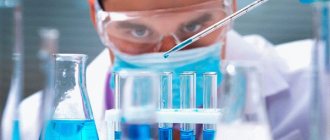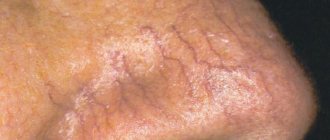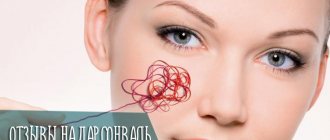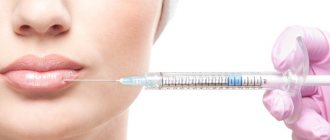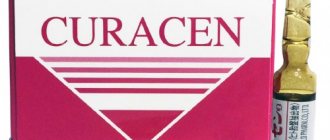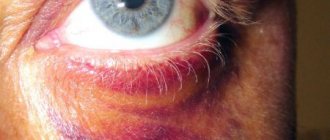Mesotherapy procedure for rosacea
This procedure consists of administering various drug combinations in small doses under the skin. Mesotherapy was created by the outstanding French physician Michel Pistor and was used to treat varicose veins, neurological diseases and respiratory diseases, as well as to combat migraines.
Preparation for the procedure
- the patient should not use aspirin two weeks before the injection date;
- A few hours before the procedure, the doctor should treat the patient’s skin with an anesthetic cream.
The dosage of the administered drug is about 0.1 ml. The procedure goes very quickly, and pain is almost completely absent. The pain of mesotherapy depends on the degree of skin sensitivity and pain threshold. Since the injections are not deep, the procedure does not cause much pain. The injected drug is quickly absorbed and does not spread under the skin.
Injection methods
- manually (the procedure is carried out by a doctor using a syringe);
- using a special apparatus.
Despite the fact that the latter method causes virtually no discomfort for the patient, the manual injection method is considered the most accurate and effective in the treatment of rosacea.
Indications
The proven and time-tested effectiveness of the mesotherapy procedure allows it to be used to solve a wide range of skin problems on the face and neck.
- Dry and sagging skin
- Pimples and acne
- Dark spots
- Violation of facial oval
- Local fat deposits (double chin, etc.)
- Cuperosis
- Wrinkles and other age-related skin changes
- Scars
- As preparation for plastic surgery
During the examination, the cosmetologist assesses the condition of the patient’s skin, and, in accordance with the individual characteristics of the skin and its problems, prescribes a course of facial mesotherapy procedures with the appropriate drug.
The clinic is very careful about the choice of drugs for mesotherapy; in the practice of the cosmetologist, only proven and effective drugs from the world's best brands are used.
Effect of the procedure
It is worth noting that mesotherapy is part of a whole range of measures necessary to completely get rid of rosacea. The procedure helps saturate the skin with essential nutrients and microelements, which contributes to its healing.
Experts recommend resorting to mesotherapy for preventive purposes and in the early stages of the disease.
Mesotherapy has a complex effect on the skin:
- strengthens the walls of blood vessels;
- normalizes the process of skin oxygenation;
- prevents the appearance of wrinkles;
- has a rejuvenating effect;
- improves blood circulation;
- restores skin color and structure.
The procedure has the most effective result if the treatment of rosacea takes place in several stages:
- The course of treatment is two months, injections are given once a week;
- Once a month injections are performed to maintain the achieved result.
Couperosis - what is it?
What are the causes of rosacea?
As mentioned earlier, when blood circulation is impaired, rosacea occurs. In turn, circulatory disorders occur when the elasticity of blood vessels decreases.
As metabolism deteriorates, the amount of oxygen and nutrients in cells decreases, and the number of breakdown products increases. Often the situation is aggravated by the incorrect use of cosmetics, the influence of sudden temperature changes, and stress. Because of this, short-term redness begins to become regular.
It is known from medicine that there are no muscle fibers in the walls of capillaries, which means that when the vessels dilate, it is impossible to return to their original size. When elasticity decreases, the walls of blood vessels cannot cope with the load, become overfilled with blood and enlarge. In most cases, the reasons for decreased elasticity lie in genetic pathologies, sclerotic modifications of blood vessels, and all kinds of inflammation that arise when the immune system is weakened.
What can lead to rosacea?
By far the most popular cause of rosacea is heredity. Obviously, it is impossible to cure something that is genetic, but modern medicine offers various ways to prevent and treat this disease. The action of the methods listed below is based on the factors leading to the disease.
If your life is full of stress and nervous overload, then the appearance of rosacea should not come as a surprise to you. During nervous tension, the concentration of catecholamines in the blood increases, which constrict blood vessels. The pressure rises, the walls expand and disease occurs. Moreover, the more often you are exposed to stress, the faster rosacea becomes an illness on a regular basis.- Sometimes rosacea is a consequence of diseases of the stomach, liver, intestines, etc. Ailments of this type disrupt the process of absorption of vitamins and enzymes, including ascorbic acid. And these substances are very important - they are responsible for blood clotting.
- Prolonged exposure to the sun can bring various complications to the body, one of which is the appearance of rosacea. Ultraviolet waves can expand the walls of blood vessels and increase the concentration of histamine and bradykinin mediators. Thus, damage and dilation of blood vessels occurs, leading to disease.
- Millions of women around the world regularly steam their faces before any cosmetic procedures. And for many years cosmetologists have not been able to reach them. A common beauty “life hack” leads to long-term dilation of the walls of blood vessels, which, as mentioned earlier, is one of the causes of rosacea. This also includes a sharp change in temperature: summer time, baths, saunas, frost, strong cold wind, frostbite and more.
- People suffering from various hypertension diseases and vegetative-vascular dystonia, as well as heart failure, are susceptible to rosacea.
- Couperosis tends to occur due to hormonal imbalances inherent in pregnant women or other reasons.
- One of the indirect causes of rosacea is an unhealthy lifestyle and diet, among other things. That is, a person who, for example, loves spicy foods, smokes or abuses alcohol should not be surprised to discover rosacea. Harmful substances contained in tobacco smoke or alcohol often lead to vasodilation.
Thus, we advise you to carefully analyze your lifestyle and the diseases to which your body is susceptible. Perhaps you can prevent the appearance of rosacea in time or choose an effective treatment for it.
What does rosacea look like?
There are rosacea in different places of the body:
- On foot
- On the face: on the nose, on the cheeks, on the forehead
- On the neck
- On hands
Side effects and possible complications
Mesotherapy rarely causes any side effects, but in some cases the following complications may occur:
- pain during the procedure (removed with painkillers);
- redness or swelling after injection;
- short-term allergic reactions;
- bruises and hematomas.
The risk of side effects when treating rosacea with mesotherapy is minimized if the procedure is performed by an experienced specialist.
Treatment of rosacea with laser
The essence of the technique. The laser beam is directed to an area of skin with dilated capillaries, causes them to heat up to 70 and “seals them”, removing them from the blood circulation process. The capillary treated in this way gradually resolves, and along with it the defect – the spider vein – disappears. The blood supply to tissues is not disrupted, due to the fact that previously uninvolved collaterals (branches of blood vessels) are involved in the process.
Features of the technique. After laser removal of rosacea, as a rule, no pigmentation, scars or scars remain. Do not panic if the skin treated with a laser beam turns red (the redness lasts for two days), then bruises (swelling) and a crust appears. These formations will soon resolve, but provided that no attempts are made to remove them forcibly, the only thing that will help speed up the healing process is treating the skin with preparations containing panthenol.
Laser treatment of rosacea (coagulation or sclerotization of blood vessels) is carried out without anesthesia and does not cause discomfort, except for a slight tingling sensation. After treatment, the skin needs to be moisturized and protected, for which patients are prescribed appropriate cosmetics. The result of removing rosacea with a laser directly depends on the qualifications of the specialist performing the procedure, so it is better if it is a cosmetologist who understands practical phlebology.
Recommendations
While undergoing a course of mesotherapy, it is necessary to follow a diet that limits the consumption of fatty foods. During treatment, it is recommended to stop drinking alcohol and monitor your daily intake of water.
In addition, you must strictly adhere to all facial skin care tips that the doctor will give after the procedure. They will allow the skin to recover as quickly as possible and shorten the time for complete recovery.
Removal of rosacea with laser: devices used
It is believed that lasers emitting yellow or green colors work best for coagulating dilated vessels, so the following is usually used to remove rosacea:
- Neodymium laser, the beam of which has characteristics ideal for combating deformed blood vessels; For a neodymium laser, skin color, size and location of the defect do not matter. The beam power is not concentrated at one point, but is distributed evenly throughout the capture area; It is believed that a neodymium laser, equipped with a powerful cooling system, is not capable of overheating the skin and does not cause burns even if the cosmetologist accidentally makes a mistake.
- The diode laser does a good job of sclerotizing “blue” vessels and is somewhat worse at sclerotizing emerging vessels that have a red tint; The effect of using a diode laser is fully manifested two weeks after the procedure, and sometimes the desired result can be achieved after the first session.
Attention! Laser treatment of rosacea should begin two weeks after skin peeling or tanning in a solarium; When planning the procedure, you should avoid taking medications that increase the sensitivity of tissues to light. Laser treatment of rosacea has contraindications: oncology, pregnancy and lactation, as well as a tendency to scar formation.
Contraindications
- individual intolerance to injection components;
- pregnancy and lactation;
- hypertension;
- acute bleeding;
- neuralgia of the optic and trigeminal nerves;
- diabetes;
- inflammatory processes on the skin;
- active stage of infectious diseases;
- mental illness;
- epilepsy.
Before determining the method of treating rosacea, you must consult a cosmetologist and undergo an examination.
Today, there are various ways to combat rosacea. Most specialists give preference to mesotherapy, since this procedure not only effectively copes with the problem of dilated capillaries, but also promotes collagen production, improves complexion and skin condition.
Insidious rosacea
The strange word “cooperosis” has French roots and is translated as “copper rose”. And although the name of this common disease of the epidermis is romantic, in its neglected state it looks completely unaesthetic. The skin is covered with red or bluish veins, intertwined into intricate meshes.
But this is only the visible part of the problem. Much worse is that such a pattern indicates the fragility of blood vessels. This means that at the slightest negative impact they are destroyed. Skin cells do not receive enough nutrition, and its condition quickly begins to deteriorate. She ages rapidly, becomes dry, and sensitivity decreases.
Therefore, you need to start fighting rosacea as soon as its first symptoms become noticeable: small red dots or stars appear under the skin. These are the junctions of capillaries in which normal blood flow is disrupted. Later, the stars turn into veins and gradually spread across the face.
Involvement of laser therapy
It is recommended to begin treating skin rosacea as soon as possible after identifying the problem. If there is no timely treatment, the disease can progress and gradually spread to larger areas of the face. In order to cure skin rosacea, a modern technique can be used - laser therapy.
During the procedure, the laser will only treat the affected area of skin. During the procedure, a laser beam penetrates the area of the affected vessel or capillary and heats it from the inside. This contributes to the gradual gluing of the affected vessels and elimination of the problem.
Severe and progressive skin rosacea can be eliminated using laser therapy, however, there are some contraindications to such a procedure:
- A history of serious disturbances in the normal functioning of the cardiovascular system.
- Presence of neoplasms.
- Various diseases of infectious origin in the acute phase.
- Inflammatory skin diseases that are accompanied by suppuration.
- Diabetes.
- Rheumatoid arthritis.
- The period of bearing a child and breastfeeding.
In order for the procedure to have the best effect, the patient must prepare thoroughly. To do this you need:
- Use medications from the group of antibacterial agents before performing the procedure.
- 72 hours before the procedure, it is not recommended to use cosmetics that contain alcohol and various acids.
- Before and after laser therapy, it is recommended to use facial protection products with a high level of SPF.
After the procedure, patients will not be exposed to direct sunlight for several weeks.
Endovascular laser coagulation
The technique of endovascular laser coagulation is one of the most modern and effective. This method of therapy quickly and effectively eliminates vascular patterns on the face, and patients are able to quickly return to their normal lifestyle after the procedure.
The procedure is carried out using a long-pulse laser, which can be used to treat even the most sensitive skin. Under the influence of laser radiation, the affected vessel is deformed and completely disappears. During the procedure, the following therapeutic effects occur:
- Under the influence of the energy flow, the upper layer of the skin warms up.
- In this case, the laser affects the deeper layers of the skin and the area of the affected vessel or capillary.
- The epidermis remains intact and undamaged.
In this case, the effect of the laser is accompanied by a moderate cooling effect, which reduces the development of pain and minimizes the risk of complications.
The device has a selective effect only on the affected areas of the vessels, without affecting the surrounding soft tissue.
The preparation procedure is similar to that recommended for patients before conventional laser therapy.
Among the disadvantages, one can highlight the rather high cost of the procedure. This type of treatment is not carried out in all cosmetology clinics. It is recommended that such a procedure be performed only by experienced specialists.
Stages of the laser removal procedure for blood vessels and spider veins
- Determination of optimal parameters for the laser procedure;
- Makeup remover;
- Skin treatment with 0.05% aqueous solution of chlorhexidine bigluconate;
- Testing skin for laser exposure;
- Applying anesthetic cream for 40-60 minutes (Mesonumb);
- Removing the anesthetic cream with dry wipes;
- Direct laser exposure;
- Application of regenerating cream (Panthenol, Bipanten).
Preparation for the laser vascular removal procedure
No special preparation is required before using a laser on your face. All that the specialist will require from you on the eve of the procedure is:
- do not use peeling;
- do not visit the solarium;
- do not stay in the sun for a long time;
- do not take vitamin A.
If you have previously subjected your face to chemical or thermal procedures, then the interval between them and laser exposure should be at least 2 weeks.
Features of the recovery period
After you have had blood vessels removed from your face with a laser, your skin needs special care.
Experts recommend adhering to the following simple rules:
- Immediately after laser star removal, it is recommended to apply ice packs to the treated areas.
- After the session, the use of any cosmetics is prohibited for 24 hours.
- Use antibacterial ointment for the first few days after removal.
- Do not wet treated areas for 3 days.
- Do not use decorative cosmetics for 3 days.
- Limit physical activity and sun exposure for 2 weeks.
- During the recovery period, postpone visiting the pool.
- It is forbidden to visit baths and saunas for at least 2 months; sudden temperature changes are very harmful to the skin during this time.
- Avoid using alcohol-based facial products for at least 2-3 days after laser coagulation. The consumption of alcoholic beverages is also prohibited.
- The use of peelings and facial scrubs is not recommended for two weeks after the treatment session.
- Skin care after laser vascular removal should also include moisturizing and nourishing creams that will soothe irritated skin.
- Do not peel off the crusts that form in the areas of laser exposure, otherwise scars will form on the skin.
How the procedure works
An electrode is applied to the cleansed skin at the site of the accumulation of blood vessels or a beam is directed. The procedure time usually does not exceed 15 minutes. The number of sessions depends on the amount of work and the severity of vascular damage. Their diameter also plays a role.
1–3 sessions are enough to coagulate small capillaries, and up to 15 sessions to correct wider ones. The break between sessions is a month, sometimes two.
How many sessions are needed?
In the initial stages of the appearance of problematic blood vessels on the face, one session is enough to remove them. If the diameter of the vessels is large enough (up to 3 mm) and the affected area is large, then 2-4 procedures or more may be required. It all depends on the individual characteristics of the client and the magnitude of the existing problem.
After the first procedure, visible improvements are noticeable. Repeated procedures are prescribed until the desired result is obtained.
The Cynergy device operates 2 lasers simultaneously, which allows you to simultaneously influence superficial and deep vessels and significantly speed up the process of their removal. The number and duration of procedures is determined by a cosmetologist.
Skin care after laser removal of blood vessels
- Use of regenerating creams as needed;
- Avoid direct sunlight for 4 weeks and use sunscreen;
- For 2 weeks, you should not use scrubbing agents or procedures that injure the skin;
- Using special care to improve the results of laser treatment.
Cosmetology procedures
Modern cosmetic techniques also help to resist the formation of spider veins. To remove blood vessels on the face, only a specialist can choose an effective method: for example, at the initial stage, hardware lymphatic drainage is well suited, it helps strengthen the walls of blood vessels and normalizes microcirculation. Listed here are the most effective methods for removing blood vessels on the face.
Laser treatment
Laser treatment of vascular mesh or coagulation for rosacea is considered one of the most effective methods of cosmetology, since it does not leave any traces, does not take much time and does not require pain relief. The method is also characterized by high accuracy. The vessel is heated to a temperature at which it is soldered without affecting nearby tissues. Excellent results in treatment can be achieved when supplemented with subsequent courses of vascular-strengthening ozone therapy or mesotherapy. With this approach, rejuvenation of the skin is also observed. Photos of skin rosacea treatment: before and after the procedure:
Photorejuvenation
The photorejuvenation technique involves the selective influence of light pulses on areas of skin on the face injured by rosacea. Cells absorb intense light in parts, and the load does not apply to healthy tissue. But a photoflash only eliminates external defects, and it does not affect the cause itself in any way.
Mesotherapy
This method of treating rosacea on the skin is based on the targeted administration of microinjections with a special medicine under the skin into problem areas. With mesotherapy, not only the drug affects the affected skin; the impact of the needle on biological active points also improves overall well-being.
Peelings
Peeling for rosacea on the face raises a lot of controversy. There are supporters and opponents of the procedure among professionals. Any external impact on the skin with rosacea should be carried out carefully and superficially, so as not to further disrupt the microcirculation of facial skin vessels.
Only chemical peeling can be used to exfoliate skin with obvious vascular network. Preparations for rosacea should have a low content of enzymes and acids, and peeling can only be superficial.
Beautek therapy
This is a modern cosmetology technique that is suitable for treating a pronounced network of blood vessels on the face. This therapy is carried out under computer control. Skin with obvious disorders is treated with gel, and then pulsed microcurrent is applied to acupuncture points.
The computer sets the state of the cells itself, sending impulses of suitable strength. The patient does not feel any discomfort, but due to its high efficiency and the absence of any inconvenience, the procedure is one of the most expensive.
Thermo- or electrocoagulation
This is a rather outdated and traumatic method of treating rosacea, after which there is a risk of scarring and age spots. Nowadays, due to the development of a large number of more accessible and less traumatic methods of exposure, the procedure is almost never performed.
Ozone therapy
Spider veins on the face are pricked and ozone is injected. This is how an oxidative reaction occurs, and the damaged vessel is destroyed, the skin is simultaneously filled with oxygen, receiving powerful healing.
Face massage
If rosacea develops, it is forbidden to use hard towels, perform steam inhalations with essential oils, and also do not perform mechanical facial cleansing or use cosmetic massagers.
This current improves metabolic processes and restores the elasticity of the epidermis, activating its protective properties. Lymphatic drainage massage is also used to reduce blood pressure in the vessels. It reduces redness and helps promote blood flow.
Cuperosis: treatment methods
The most common ways to get rid of rosacea that has already occurred include:
- electrocoagulation;
- photoslerosis;
- laser therapy;
- cryodestruction.
The choice of one method or another is influenced by the severity of rosacea and the individual condition of the patient’s blood vessels. For the most comfortable and at the same time long-term relief from the problem, it is recommended to undergo a course of procedures, between each of which a short break is taken to restore the skin.
Preventive methods aimed at strengthening blood vessels (mesotherapy, massage, compresses, etc.) are good before the onset of the disease. If rosacea has already appeared, they are powerless. In this case, the only solution is the destruction of dilated vessels. In this case, there is no disruption of the blood supply to the skin.
